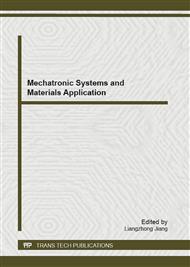[1]
Vineeta Agarwal, and Alck Vishwakarma, A Comparative Study of PWM Schemes for Grid Connected PV Cell, in Proc. 2007 IEEE The 7th International Conference on Power Electronics and Drive Systems, pp.1769-1775.
DOI: 10.1109/peds.2007.4487948
Google Scholar
[2]
Cuauhtemoc Rodriguez, and Gehan A. J Amaratunga, Analytic Solution to the Photovoltaic Maximum Power Point Problem, IEEE Transactions on Circuit and Systems, Vol. 54, No. 9, p.2054–2060, September, (2007).
DOI: 10.1109/tcsi.2007.902537
Google Scholar
[3]
D. Shmilovitz, On the control of photovoltaic maximum power point tracker via output parameters, IEE Proc. -Electr. Power Appl., Vol. 152, No. 2, p.239–248, March, (2005).
DOI: 10.1049/ip-epa:20040978
Google Scholar
[4]
Trishan Esram. Comparison of Photovoltaic Array Maximum Power Point Tracking Techniques, IEEE Transactions on Energy Conversion, vol. 22, No. 2, pp.439-449, June, (2007).
DOI: 10.1109/tec.2006.874230
Google Scholar
[5]
Ashish Pandey, Nivedita Dasgupta, and Ashok Kumar Mukkerjee, High-Performance Algorithms for Drift Avoidance and Fast Tracking in Solar MPPT System, IEEE Transactions on Energy Conversion, Vol. 23, No. 2, p.681–689, June, (2008).
DOI: 10.1109/tec.2007.914201
Google Scholar
[6]
S. Jain, and V. Agarwal. Comparision of the performance of maximum power point tracking schemes applied to single-stage grid-connected photovoltaic systems, IET Electr. Power Appl., Vol. 1, No. 5, pp.753-762, September, (2007).
DOI: 10.1049/iet-epa:20060475
Google Scholar
[7]
J. Nelson, The Physics of Solar Cells. London, U.K.: Imperial College Press, (2003).
Google Scholar
[8]
Z. M. Salameh, D, Fouad, and A. William, Step-down maximum power point tracker for photovoltaic systems, Solar Energy, Vol. 46, No. 5, pp.279-282, (1991).
DOI: 10.1016/0038-092x(91)90095-e
Google Scholar
[9]
Tsai-Fu Wu, Chien-Hsuan Chang, and Yu-Kai Chen, A Fuzzy-Logic-Controlled Single-Stage Converter for PV-Powered Lighting System Application, IEEE Transactions on Industrial Electronics, Vol. 47, No. 2, pp.287-296, April (2000).
DOI: 10.1109/41.836344
Google Scholar
[10]
Nicola Femia, Giovanni Petrone, Giovanni Spagnuolo, and Massimo Vitelli, Optimization of Perturb and Observe Maximum Power Point Tracking Method, IEEE Trans. on Power Electronic, Vol. 20, No. 4, pp.963-972, July, (2005).
DOI: 10.1109/tpel.2005.850975
Google Scholar
[11]
Mummadi Veerachary, Tomonobu Senjyu, and Katsumi Uezato, Feedforward Maximum Power Point Tracking of PV Systems Using Fuzzy Controller, IEEE Transactions on Aerospace and Electronic System, Vol. 38, No. 3, pp.969-981, July (2002).
DOI: 10.1109/taes.2002.1039412
Google Scholar
[12]
Mummadi Veerachary, Tomonobu Senjyu, and Katsumi Uezato, Neural-Network-Based Maximum-Power-Point Tracking of Coupled-Inductor Interleaved-Boost-Converter-Supplied PV System Using Fuzzy Controller, IEEE Transactions on Induetrial Electronics, Vol. 50, No. 4, pp.749-758, August (2003).
DOI: 10.1109/tie.2003.814762
Google Scholar


